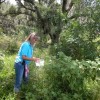 Tropical soda apple is a prickly shrub native to South America. First reported in Glades Co., Florida in 1988, it later spread to Georgia, Alabama, Louisiana, Texas, Mississippi, Tennessee, North Carolina, and South Carolina. It is a major problem in pastures and conservation areas. Negative impacts of tropical soda apple include reduction of cattle stocking rates, competition with native plants, and the costs associated with its control. Dense thickets of the weed also can disrupt the movement of wildlife. This 4-page fact sheet provides a summary of the major steps of the successful biological control program against tropical soda apple in Florida. The article covers the importance of the weed, identification and biology of the biological control agent, rearing and release efforts, establishment and impact, and efforts to communicate the outcomes of the program to stakeholders. Written by R. Diaz, J. Medal, K. Hibbard, A. Roda, A. Fox, S. Hight, P. Stansly, B. Sellers, J. Cuda and W. A. Overholt, and published by the UF Department of Entomology and Nematology, November 2012.
Tropical soda apple is a prickly shrub native to South America. First reported in Glades Co., Florida in 1988, it later spread to Georgia, Alabama, Louisiana, Texas, Mississippi, Tennessee, North Carolina, and South Carolina. It is a major problem in pastures and conservation areas. Negative impacts of tropical soda apple include reduction of cattle stocking rates, competition with native plants, and the costs associated with its control. Dense thickets of the weed also can disrupt the movement of wildlife. This 4-page fact sheet provides a summary of the major steps of the successful biological control program against tropical soda apple in Florida. The article covers the importance of the weed, identification and biology of the biological control agent, rearing and release efforts, establishment and impact, and efforts to communicate the outcomes of the program to stakeholders. Written by R. Diaz, J. Medal, K. Hibbard, A. Roda, A. Fox, S. Hight, P. Stansly, B. Sellers, J. Cuda and W. A. Overholt, and published by the UF Department of Entomology and Nematology, November 2012.
http://edis.ifas.ufl.edu/in971
Author: dihagan
Classical Biological Control of Air Potato in Florida (ENY864/IN957)
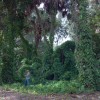 Air potato was introduced to Florida in 1905. By the 1980s, its vines were growing in thickets, waste areas, and hedges or fencerows in many parts of south and central Florida. By 1999, it was recognized as transforming plant communities by displacing native species, changing community structure and disrupting ecological functions. The air potato leaf beetle is a rather large, orange-red Asian leaf beetle. It feeds and develops only on air potato. The USDA-ARS Invasive Plant laboratory in Fort Lauderdale acquired this beetle from China and has begun an ambitious release program aimed at controlling air potato. This 3-page fact sheet was written by T. D. Center and W. A. Overholt, and published by the UF Department of Entomology and Nematology, October 2012.
Air potato was introduced to Florida in 1905. By the 1980s, its vines were growing in thickets, waste areas, and hedges or fencerows in many parts of south and central Florida. By 1999, it was recognized as transforming plant communities by displacing native species, changing community structure and disrupting ecological functions. The air potato leaf beetle is a rather large, orange-red Asian leaf beetle. It feeds and develops only on air potato. The USDA-ARS Invasive Plant laboratory in Fort Lauderdale acquired this beetle from China and has begun an ambitious release program aimed at controlling air potato. This 3-page fact sheet was written by T. D. Center and W. A. Overholt, and published by the UF Department of Entomology and Nematology, October 2012.
http://edis.ifas.ufl.edu/in957
Late Blight of Potato and Tomato (PP301)
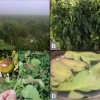 Both potato and tomato are susceptible to late blight, an aggressive disease capable of rapidly destroying entire fields. The disease is distributed worldwide and occurs wherever tomatoes or potatoes are grown and conditions favor disease development. This 4-page fact sheet was written by Ryan Donahoo and Pamela Roberts, and published by the UF Department of Plant Pathology, December 2012.
Both potato and tomato are susceptible to late blight, an aggressive disease capable of rapidly destroying entire fields. The disease is distributed worldwide and occurs wherever tomatoes or potatoes are grown and conditions favor disease development. This 4-page fact sheet was written by Ryan Donahoo and Pamela Roberts, and published by the UF Department of Plant Pathology, December 2012.
http://edis.ifas.ufl.edu/pp301
Living Well to Keep Your Pressure Down (FCS8690/FY305)
 High blood pressure, or hypertension, can cause serious health problems. It makes your heart work harder and can damage your blood vessels even if you feel okay. Everyone should have their blood pressure checked regularly. If you have certain risk factors you are more likely to have high blood pressure. Follow these recommendations to help reduce your risk for high blood pressure. This 6-page fact sheet was written by Linda B. Bobroff, and published by the UF Department of Family Youth and Community Sciences, January 2013.
High blood pressure, or hypertension, can cause serious health problems. It makes your heart work harder and can damage your blood vessels even if you feel okay. Everyone should have their blood pressure checked regularly. If you have certain risk factors you are more likely to have high blood pressure. Follow these recommendations to help reduce your risk for high blood pressure. This 6-page fact sheet was written by Linda B. Bobroff, and published by the UF Department of Family Youth and Community Sciences, January 2013.
http://edis.ifas.ufl.edu/fy305
Food Processing: The Meat We Eat (AN283)
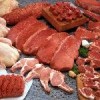 Meat processing technology is used to produce many of the foods we enjoy, such as hot dogs, hamburgers, and chicken nuggets. Recently, the media has focused on certain meat products, giving them names such as “pink slime” and “meat glue.” The names of these products might have many people wondering what we are eating and how the meat we eat is produced. Part of being a good consumer is learning about what you eat, from how the food is made to whether the food is safe. This publication discusses the facts about meat processing so you can make knowledgeable decisions about the meat you eat. This 5-page fact sheet was written by Erica L. Bub, Keith Schneider, Chad Carr, and Matt Hersom, and published by the UF Department of Animal Sciences, December 2012.
Meat processing technology is used to produce many of the foods we enjoy, such as hot dogs, hamburgers, and chicken nuggets. Recently, the media has focused on certain meat products, giving them names such as “pink slime” and “meat glue.” The names of these products might have many people wondering what we are eating and how the meat we eat is produced. Part of being a good consumer is learning about what you eat, from how the food is made to whether the food is safe. This publication discusses the facts about meat processing so you can make knowledgeable decisions about the meat you eat. This 5-page fact sheet was written by Erica L. Bub, Keith Schneider, Chad Carr, and Matt Hersom, and published by the UF Department of Animal Sciences, December 2012.
http://edis.ifas.ufl.edu/an283
Healthy Living: Tips for Staying Regular (FCS8565/FY072)
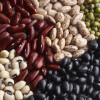 Constipation means having a bowel movement fewer than three times a week. Stools are usually hard and can be painful to pass. Constipation is common among older adults.This 1-page fact sheet was written by Linda B. Bobroff, and published by the UF Department of Family Youth and Community Sciences, January 2013.
Constipation means having a bowel movement fewer than three times a week. Stools are usually hard and can be painful to pass. Constipation is common among older adults.This 1-page fact sheet was written by Linda B. Bobroff, and published by the UF Department of Family Youth and Community Sciences, January 2013.
http://edis.ifas.ufl.edu/fy072
Management of Insect and Mite Resistance in Ornamental Crops (ENY843/IN715)
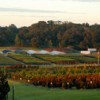 Resistance of arthropods to crop management chemicals has been problematic since the early era of synthetic organic pesticides. During the 1970s and early 1980s leafminer outbreaks heavily damaged herbaceous ornamental crops such as chrysanthemum, gypsophila, aster, and marigold in fields, shade houses and greenhouses. Several effective insecticides including organophosphates, carbamates, pyrethroids, and a triazine were identified for leafminer control during the outbreak; however, control was short-lived as the leafminer developed resistance to each insecticide.This 11-page fact sheet was written by James F. Price, Elzie McCord, Jr., and Curtis Nagle, and published by the UF Department of Entomology and Nematology, November 2012.
Resistance of arthropods to crop management chemicals has been problematic since the early era of synthetic organic pesticides. During the 1970s and early 1980s leafminer outbreaks heavily damaged herbaceous ornamental crops such as chrysanthemum, gypsophila, aster, and marigold in fields, shade houses and greenhouses. Several effective insecticides including organophosphates, carbamates, pyrethroids, and a triazine were identified for leafminer control during the outbreak; however, control was short-lived as the leafminer developed resistance to each insecticide.This 11-page fact sheet was written by James F. Price, Elzie McCord, Jr., and Curtis Nagle, and published by the UF Department of Entomology and Nematology, November 2012.
http://edis.ifas.ufl.edu/in715
Using Tensiometers for Vegetable Irrigation Scheduling in Miami-Dade County (ABE326/TR015)
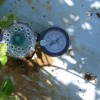 A tensiometer is a simple and relatively inexpensive tool that can be used to schedule irrigation in Miami-Dade County vegetable crops. Tensiometers continuously measure soil water potential or tension. If the tension in the soil is high, plants have to use more energy to extract soil water. If tension in the soil is low, then plants have lower energy requirements to extract soil water. This 6-page fact sheet was written by Kati W. Migliaccio, Teresa Olczyk, Yuncong Li, Rafael Muñoz-Carpena, and Tina Dispenza, and published by the UF Department of Agricultural and Biological Engineering, December 2012.
A tensiometer is a simple and relatively inexpensive tool that can be used to schedule irrigation in Miami-Dade County vegetable crops. Tensiometers continuously measure soil water potential or tension. If the tension in the soil is high, plants have to use more energy to extract soil water. If tension in the soil is low, then plants have lower energy requirements to extract soil water. This 6-page fact sheet was written by Kati W. Migliaccio, Teresa Olczyk, Yuncong Li, Rafael Muñoz-Carpena, and Tina Dispenza, and published by the UF Department of Agricultural and Biological Engineering, December 2012.
http://edis.ifas.ufl.edu/tr015
Swarm Control for Managed Beehives (ENY160/IN970)
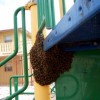 Honey bee swarms are a normal sign of a productive and strong honey bee colony. The population of honey bees in the environment grows and genes are exchanged as the new queen in the parent colony mates with drones from other colonies in the surrounding environment. Unfortunately, this activity often conflicts with the goals of the beekeeper, so good colony management includes swarm prevention. During the swarm season, hive owners should undertake proactive beekeeping practices to alter colonies in response to potential swarming behavior. In this way, the beekeeper maintains strong colonies with greater honey production and the potential to split and increase the total number of colonies, all of which makes beekeeping much more profitable for hive owners. This 6-page fact sheet was written by Sara DeBerry, John Crowley, and James D. Ellis, and published by the UF Department of Entomology and Nematology, November 2012.
Honey bee swarms are a normal sign of a productive and strong honey bee colony. The population of honey bees in the environment grows and genes are exchanged as the new queen in the parent colony mates with drones from other colonies in the surrounding environment. Unfortunately, this activity often conflicts with the goals of the beekeeper, so good colony management includes swarm prevention. During the swarm season, hive owners should undertake proactive beekeeping practices to alter colonies in response to potential swarming behavior. In this way, the beekeeper maintains strong colonies with greater honey production and the potential to split and increase the total number of colonies, all of which makes beekeeping much more profitable for hive owners. This 6-page fact sheet was written by Sara DeBerry, John Crowley, and James D. Ellis, and published by the UF Department of Entomology and Nematology, November 2012.
http://edis.ifas.ufl.edu/in970
Preserving Woodenware in Beekeeping Operations (ENY125/AA244)
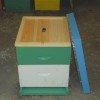 The predominant material used to construct honey bee colonies in the U.S. is wood. Though honey bee hive components are simple in design, they are subjected to many extreme management techniques that cause wear and tear, ultimately shortening the life of the equipment. This article discusses how to protect colony woodenware, particularly the pieces that are exposed to the elements. These include the bottom board, hive body/supers, and lids. This 4-page fact sheet was written by J. D. Ellis, W. H. Kern, and C. M. Zettel Nalen, and published by the UF Department of Entomology and Nematology, June 2012.
The predominant material used to construct honey bee colonies in the U.S. is wood. Though honey bee hive components are simple in design, they are subjected to many extreme management techniques that cause wear and tear, ultimately shortening the life of the equipment. This article discusses how to protect colony woodenware, particularly the pieces that are exposed to the elements. These include the bottom board, hive body/supers, and lids. This 4-page fact sheet was written by J. D. Ellis, W. H. Kern, and C. M. Zettel Nalen, and published by the UF Department of Entomology and Nematology, June 2012.
http://edis.ifas.ufl.edu/aa244
2013 Florida Blueberry Integrated Pest Management Guide (HS1156/HS380)
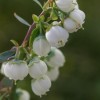 Recommendations are based on information from the manufacturer’s label and performance data from research and Extension field tests. This 31-page pest management guide was adapted for Florida by Jeffrey G. Williamson, Philip F. Harmon, Oscar E. Liburd, and Peter Dittmar, from the Southeast Regional Blueberry Integrated Management Guide, and published by the UF Department of Horticultural Sciences, November 2012.
Recommendations are based on information from the manufacturer’s label and performance data from research and Extension field tests. This 31-page pest management guide was adapted for Florida by Jeffrey G. Williamson, Philip F. Harmon, Oscar E. Liburd, and Peter Dittmar, from the Southeast Regional Blueberry Integrated Management Guide, and published by the UF Department of Horticultural Sciences, November 2012.
http://edis.ifas.ufl.edu/hs380
Guia de seguridad para el uso de pesticidas en el hogar (PI244)
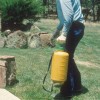 En este documento se describen las medidas que ayudarán en la toma de decisiones inteligentes y seguras sobre la utilización de plaguicidas en el hogar y césped/jardín. This 4-page fact sheet was written by Frederick M. Fishel, and published by the UF Department of Agronomy, December 2012.
En este documento se describen las medidas que ayudarán en la toma de decisiones inteligentes y seguras sobre la utilización de plaguicidas en el hogar y césped/jardín. This 4-page fact sheet was written by Frederick M. Fishel, and published by the UF Department of Agronomy, December 2012.
http://edis.ifas.ufl.edu/pi244
Equipo de Proteccion Personal para la Manipulacion de Pesticidas (PI243)
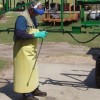 Este documento describe diversos artículos de equipo de protección personal (EPP) que se usan para proteger el cuerpo humano del contacto con pesticidas o residuos de pesticidas. El EPP incluye elementos tales como overoles o trajes protectores, calzado, guantes, delantales, mascarillas, gafas y sombreros. This 12-page fact sheet was written by Frederick Fishel, and published by the UF Department of Agronomy, December 2012.
Este documento describe diversos artículos de equipo de protección personal (EPP) que se usan para proteger el cuerpo humano del contacto con pesticidas o residuos de pesticidas. El EPP incluye elementos tales como overoles o trajes protectores, calzado, guantes, delantales, mascarillas, gafas y sombreros. This 12-page fact sheet was written by Frederick Fishel, and published by the UF Department of Agronomy, December 2012.
http://edis.ifas.ufl.edu/pi243
Identification and Control of Southern Sandbur (Cenchrus echinatus L.) in Hayfields (SSAGR364/AG373)
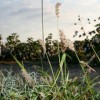 Southern sandbur is an annual grass that grows in pastures and cropland throughout the warm areas of the southern United States from Virginia to California. This native grass is adapted to dry, sandy soils and has a shallow, fibrous root system. It can easily invade a poorly managed field, diminishing the quality of a hay crop or grazing pasture. Southern sandbur seeds start to germinate in late spring, and germination continues through the summer and fall. Flowering occurs in late fall, and growth is consistent until the first frost. This 2-page fact sheet was written by Hunter Smith, Jason Ferrell, and Brent Sellers, and published by the UF Department of Agronomy, December 2012.
Southern sandbur is an annual grass that grows in pastures and cropland throughout the warm areas of the southern United States from Virginia to California. This native grass is adapted to dry, sandy soils and has a shallow, fibrous root system. It can easily invade a poorly managed field, diminishing the quality of a hay crop or grazing pasture. Southern sandbur seeds start to germinate in late spring, and germination continues through the summer and fall. Flowering occurs in late fall, and growth is consistent until the first frost. This 2-page fact sheet was written by Hunter Smith, Jason Ferrell, and Brent Sellers, and published by the UF Department of Agronomy, December 2012.
http://edis.ifas.ufl.edu/ag373
The Florida Bull Test 2011-2012 (AN284)
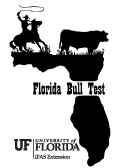 The North Florida Research and Education Center in Marianna, Florida annually hosts the Florida Bull Test. By controlling the environmental factors and taking Expected Progeny Differences (EPD’s) into account, the data clearly emphasizes the dual importance of genetics and environment in all cattle types. This 5-page fact sheet presents the procedures, rules, and results of the 2011-2012 test. Written by G. Cliff Lamb and Nicolas DiLorenzo, and published by the UF Department of Animal Sciences, December 2012.
The North Florida Research and Education Center in Marianna, Florida annually hosts the Florida Bull Test. By controlling the environmental factors and taking Expected Progeny Differences (EPD’s) into account, the data clearly emphasizes the dual importance of genetics and environment in all cattle types. This 5-page fact sheet presents the procedures, rules, and results of the 2011-2012 test. Written by G. Cliff Lamb and Nicolas DiLorenzo, and published by the UF Department of Animal Sciences, December 2012.
http://edis.ifas.ufl.edu/an284
Application of Ionophores in Cattle Diets (AN285)
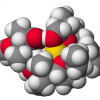 Beef cattle producers should consider using ionophores to increase calf gain and gain efficiency in a cost-effective manner. Ionophores are feed additives used in cattle diets to increase feed efficiency and body weight gain. They are compounds that alter rumen fermentation patterns. Ionophores can be fed to any class of cattle and can be used in any segment of the beef cattle industry. Similar to many other feed additives, ionophores are fed in very small amounts and supplied via another feedstuff as carrier for intake. Ionophores decrease incidence of coccidiosis, bloat, and acidosis in cattle. This 4-page fact sheet was written by Matt Hersom and Todd Thrift, and published by the UF Department of Animal Sciences, December 2012.
Beef cattle producers should consider using ionophores to increase calf gain and gain efficiency in a cost-effective manner. Ionophores are feed additives used in cattle diets to increase feed efficiency and body weight gain. They are compounds that alter rumen fermentation patterns. Ionophores can be fed to any class of cattle and can be used in any segment of the beef cattle industry. Similar to many other feed additives, ionophores are fed in very small amounts and supplied via another feedstuff as carrier for intake. Ionophores decrease incidence of coccidiosis, bloat, and acidosis in cattle. This 4-page fact sheet was written by Matt Hersom and Todd Thrift, and published by the UF Department of Animal Sciences, December 2012.
http://edis.ifas.ufl.edu/an285
Sturgeon Aquaculture: Specialized Techniques: Determining the Sex of Sturgeon by Direct Examination of the Gonad Using a Minimally Invasive Surgical Procedure (FA183)
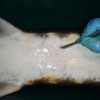 Because male sturgeon are harvested for meat at 2-4 years of age and females are retained for caviar production, being able to determine the sex of individual sturgeon has specific economical advantages. But it is difficult to tell females from males, especially when the fish are young (from hatch to 3 years old). This 5-page fact sheet describes the standard method and tools for determining the sex of sturgeon by direct examination of the gonad using a minimally invasive surgical procedure. Written by Frank A. Chapman and Joel P. Van Eenennaam, and published by the UF Department of Fisheries and Aquatic Sciences, November 2012.
Because male sturgeon are harvested for meat at 2-4 years of age and females are retained for caviar production, being able to determine the sex of individual sturgeon has specific economical advantages. But it is difficult to tell females from males, especially when the fish are young (from hatch to 3 years old). This 5-page fact sheet describes the standard method and tools for determining the sex of sturgeon by direct examination of the gonad using a minimally invasive surgical procedure. Written by Frank A. Chapman and Joel P. Van Eenennaam, and published by the UF Department of Fisheries and Aquatic Sciences, November 2012.
http://edis.ifas.ufl.edu/fa183
Design and Implementation of Edible Plant Demonstration Gardens: A Case Study of the Putnam County Extension Edible Garden (ENH1205/EP466)
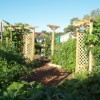 Demonstration gardens are a collection of plants assembled and organized in a manner that allows garden visitors to access and study them. Most gardens are designed with a particular focus and include plants that support the purpose and educational theme of the garden. This case study features an edible plant demonstration garden that was designed and installed in Hastings, Florida, on the Extension office grounds. The UF/IFAS program and the Partnership for Water, Agriculture, and Community Sustainability (FPWACS) designed and implemented the demonstration garden using a step-by-step process that is discussed in this 15-page fact sheet written by Gail Hansen, Joseph Sewards, Rebecca Almeida, and Andrew Dunn, and published by the UF Department of Environmental Horticulture, November 2012.
Demonstration gardens are a collection of plants assembled and organized in a manner that allows garden visitors to access and study them. Most gardens are designed with a particular focus and include plants that support the purpose and educational theme of the garden. This case study features an edible plant demonstration garden that was designed and installed in Hastings, Florida, on the Extension office grounds. The UF/IFAS program and the Partnership for Water, Agriculture, and Community Sustainability (FPWACS) designed and implemented the demonstration garden using a step-by-step process that is discussed in this 15-page fact sheet written by Gail Hansen, Joseph Sewards, Rebecca Almeida, and Andrew Dunn, and published by the UF Department of Environmental Horticulture, November 2012.
http://edis.ifas.ufl.edu/ep466
Finding Grant Opportunities to Support County Extension Programs (WC134)
 This 3-page fact sheet presents information about where to look for grant opportunities, what to look for when reviewing grant opportunities, and how to determine if the opportunity fits your idea. Written by Amy Harder, Alexa Lamm, and Sebastian Galindo, and published by the UF Department of Agricultural Education and Communication, December 2012.
This 3-page fact sheet presents information about where to look for grant opportunities, what to look for when reviewing grant opportunities, and how to determine if the opportunity fits your idea. Written by Amy Harder, Alexa Lamm, and Sebastian Galindo, and published by the UF Department of Agricultural Education and Communication, December 2012.
http://edis.ifas.ufl.edu/wc134
Mange in Companion Animals (ENY289/IN953)
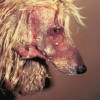 Mange is a persistent skin condition of mammals caused by infestation with parasitic mites. Mites are tiny arthropods, usually less than 1 mm in length and difficult to see with the naked eye. Adult mites have eight legs, and larvae have six. The effect of the mites on the animal’s skin, called “mange,” is the most visible sign of an infestation. This 6-page fact sheet describes several skin conditions commonly caused by parasitic mites in domestic animals. Written by E. N. I. Weeks and P. E. Kaufman, and published by the UF Department of Entomology and Nematology, September 2012.
Mange is a persistent skin condition of mammals caused by infestation with parasitic mites. Mites are tiny arthropods, usually less than 1 mm in length and difficult to see with the naked eye. Adult mites have eight legs, and larvae have six. The effect of the mites on the animal’s skin, called “mange,” is the most visible sign of an infestation. This 6-page fact sheet describes several skin conditions commonly caused by parasitic mites in domestic animals. Written by E. N. I. Weeks and P. E. Kaufman, and published by the UF Department of Entomology and Nematology, September 2012.
http://edis.ifas.ufl.edu/in953